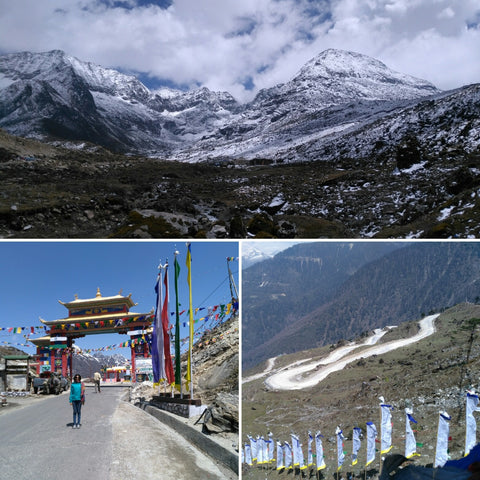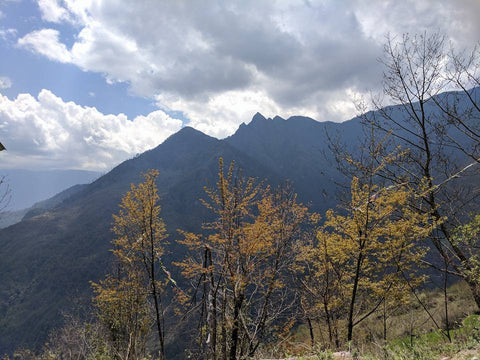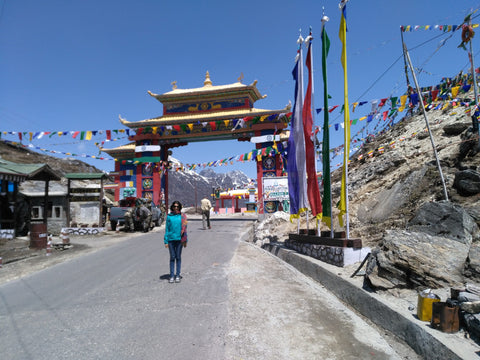
We at Mana Organics, when we are not making compost, developing products, chasing packaging suppliers, or writing blogs, love to travel. For our latest adventure, we decided on a road trip to Tawang, a remote corner of India, bordering Bhutan, and Tibet.
A Drive Over Right Arm of the Himalayas
The drive itself was a large part of this trip’s attraction, especially for Avantika. Tawang lies nestled in the Purvanchal range, or the eastern Himalayas, in North-east India. The road climbs up the sheer foothills, and then dips through mountain valleys, eventually culminating at the Sela Pass, the highest motorable road in Asia.
The road is intense, featuring steep switchbacks hugging the hard mountain face, and stunning views. Regular landslides and washouts plague the route, making progress slow. Twice on the journey we stopped for hours to wait on road repair crews to finish work. These crews comprised gangs of women, often cutting roads into the mountain with pick axes, and crushing rock for asphalt with sledge hammers.

Got Dramamine?
As we watched these tough, brave women melting tar, and cutting roads for steam rollers, we met several other travelers. Most of the foreigners were American, an anomaly in our Indian travels. We started chatting, and soon found ourselves talking about tea. We shared our favorite recipes, and made friends with Thea, our newest Mana fan! We ran into each other for the next few days in our stay in Tawang. It was great to understand Thea’s relationship with tea, and to get a first-hand perspective on our customer’s needs.
Biodiversity Hot Spot

Buss breakdown at about 700 feet (213 m)
We started in the lush tropical forests of the Brahmaputra Valley floor. They were thick with vines and ferns. Wild orchids adorned the deciduous trees in bursts of pink, purple, and white. Local assured us that the wild banana leaves, and tall Tetrameles nudiflora trees hid tigers, leopards, and sun bears. We had the good fortune of watching a great hornbill glide through the sky. We witnessed the evidence of wild elephants (e.g. poop), the hoof marks of deer and wild yaks.

View from the road at 7,300 feet (2,250 m)
As we journeyed up the steep sides of the mountains, the jungle soon gave way to thick deciduous forests. Song birds darted through the branches and goats nayed. Farmers grew vegetables and upland rice in terraced farms.
We continued to climb, the deciduous trees gradually gave way to pine. Even though it was already mid-Spring, the air was cool and dry. I put on four layers as the pine forest dwindled into tundra.

Avantika at the gate to the Sela Pass at 13,700 feet (4,170 m)
When we crested the Sela Pass, we met jagged, wind-cut rock and spots of lichen. One could not even describe it as tundra. Only as black, hard, barren, and cold except for the prayer gate strewn with brilliant blue, yellow, and red flags.
Just below the ridge, the wind died down. The rock gave way to tundra grass and thick peat. We came across a mountain lake and our first yak of the journey. Waterfalls regularly cascaded down the peak sides as we quickly dropped into the Tawang valley.

Yaks serenely grazing below the Sela Pass
The Sino-Indian War
On our journey, we passed numerous military bases. These are the legacy of the Sino-Indian War.
The Chinese have long claimed Arunachal Pradesh. Historically, Tawang, and some other portions of Arunachal Pradesh, was part of Tibet. The Tibetans had ceded these area to British India in 1914. By this treaty, Tibet relinquished several hundred square miles of its territory, including Tawang, to the British. But this treaty was not recognized by China, which claimed rights to make foreign treaties on behalf of Tibet based on a previous agreement. How the Chinese claim the rest of Arunachal is unclear.
In 1962 – during the Cuban Missile Crisis— the Chinese pressed their claim by mounting a surprise invasion. The Indian military was caught completely off guard. Despite facing an uphill battle at dizzying heights, the Chinese easily routed the Indian army, and took the entire mountain range, reaching the borders of Assam.
Then, as surprising as their invasion, the Chinese army withdrew from the area. Many theories exist regarding the exit (the supply lines were cut off, the USA had sent a carrier group to help India, etc.), but no real explanation is publicly available.
Many memorials to the Sino-Indian war dot the road to Tawang, which is maintained by the Indian army for troop movement. The most prominent is in memory of RFN Jaswant Singh Rawat. Jaswant Singh Rawat assisted by two other men, Gopal Gusain and Trilok Negi, volunteered to silence an enemy MMG. Jaswant Rawat and Gopal Gusain supported by the covering fire from Trilok Negi heroically closed within grenade throwing distance and destroyed the Chinese detachment, and then seized the MMG. Jaswant Rawat and Trilok Negi were killed as they tried to return with the captured weapon. The entire operation cost the Chinese 300 Dead and wounded with the loss to India being 2 dead and 8 wounded.
All Indian Army personnel passing by this route from General to a Jawan pay their respects Jaswant Rawat. To this day, the Indian army keeps at least half-a-dozen personnel here to take care of Rawat as if he were alive. He is served bed tea at 4.30am, breakfast at 9 am, and dinner at 7pm. His boots shined, linen washed, towels changed. He still even receives promotions.
Next to Jaswant Singh Rawat’s memorial is a snack shop overlooking the canyon. Best vegetarian momos any on the Mana team has ever eaten.

Delicious momos, even more incredible view
Check in next week when we will share our explorations of Tawang itself- its fascinating landscape, history, and Tibetan Buddhism.
